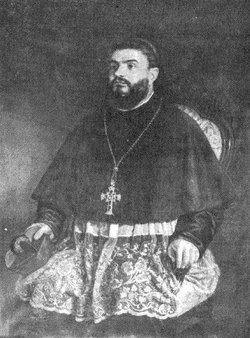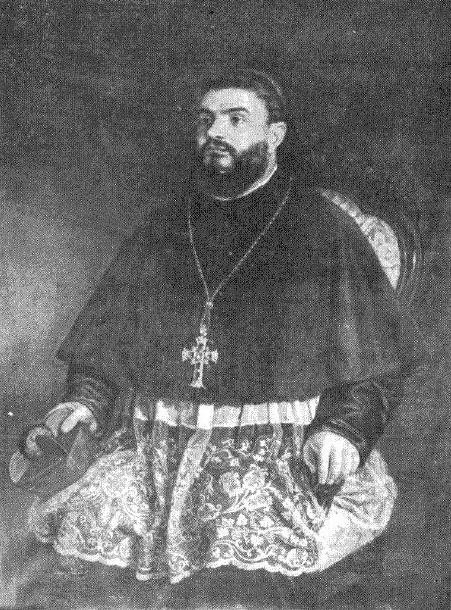At an early age he expressed a strong desire to take up religious life. He moved to Malta, where his relatives still lived, and on December 20, 1863, he joined the Franciscan Capuchin Friars, spending his first year as a novice at St. Liberata's Friary, Kalkara. One of his brothers, Canon Michael Buhagiar, became a diocesan priest.
Endowed as he was, with a bright and intelligent mind, he had excellent results in his philosophical and theological studies. His Provincial Superior, Fr. Giovanni Fedele da Gozo, on account of his very good results at the Bishop's Curia examinations, recommended him to the Minister General to pursue his studies abroad. Besides Maltese, Italian and Latin, Buhagiar had a good command of the Greek, Hebrew, French and Spanish languages.
Archbishop Gaetano Pace Forno OSA., ordained him to the priesthood on September 18, 1869. The Minister General of the Capuchin Order, who happened to be in Malta, because of the Roman upheaval, awarded him, with a 'summa cum laude' the preaching faculty in June 1871. The same General offered him the chair of lecturer in philosophy, but he declined preferring to dedicate himself to pastoral activities.
As a young priest he was, with another Capuchin friar, the first resident chaplain of the then newly opened Santa Maria Addolorata Cemetery at Paola.
Soon however he had to leave Malta. On May 2, 1872 he sailed towards Tunis, where he was appointed Apostolic Missionary by the Congregation "De Propaganda Fide" at the request of the Capuchin Bishop Mgr. Fedele Sutter, Vicar Apostolic of Tunis. His particular mission field was among the Maltese settlers at Sfax. There he spent twelve years and there he remained even after his nomination Auxiliary to the Bishop of Carthage, Cardinal Charles Allemand-Lavigerie at the early age of 37. He received his episcopal consecration with the Titular See of Ruspae on August 31, 1884, from Cardinal Lavigerie, assisted by Bishops Léon Livinhac M.Afr., and Jean-Baptiste-Frézal Charbonnier M.Afr., in Carthage.
As the Bishop of Malta, Msgr. Carmelo Scicluna was ailing, the situation of the Diocese of Malta was not at its best in the 1880's. Thus, on April 14, 1885, Buhagiar was named Apostolic Administrator of the Diocese of Malta by Pope Leo XIII. The British Authorities were surprised by the appointment of a Francophile prelate to the See of Malta, and the local clergy resented the fact that a Maltese born overseas was preferred to a Maltese born for such an important position.
In vain Leo XIII explained that being Maltese but not involved in local politics Monsignor Buhagiar was the best possible choice, but the local furor was such that when Monsignor Scicluna passed away on July 12, 1888, Buhagiar was replaced by the Bishop of Gozo, Monsignor Pietro Pace. During his short stay in Malta, Buhagiar left however his mark among the people, distinguishing himself especially through his humanitarian activities during the cholera epidemic which struck the island in 1887.
On January 8, 1891 Monsignor Buhagiar was appointed Apostolic Delegate and Envoy Extraordinary to San Domingo, Haiti and Venezuela. He died in San Domingo six months after his arrival of yellow fever, assisted by the Archbishop of Santo Domingo, Monsignor Fernando Antonio Arturo de Merino y Ramírez and his blood brother, Canon Michael, on August 10, 1891, at 11 pm., after receiving the viaticum from Archbishop Merino, aged 44.
Upon his deathbed, Bishop Buhagiar expressed his wish to be buried without a coffin. A vault was dug in the chapel of St. Francis inside the Catedral de Santa María la Menor of Santo Domingo, where a Requiem Mass was held. At the end of the Mass, four canons of the Cathedral Chapter carried the bishop's casket towards its final resting place. As the bishop was about the be buried, a rope slipped off the hands of one of the canons, Lorenzo Caro, the casket overturned and the Bishop's body rushed towards to bottom of the pit to the amazement and sadness of those present.
Shortly after his death, his brother Canon Michael was also stricken by yellow fever, dying a few days later. He was buried at the Iglesia de San Lorenzo in Santo Domingo.
At an early age he expressed a strong desire to take up religious life. He moved to Malta, where his relatives still lived, and on December 20, 1863, he joined the Franciscan Capuchin Friars, spending his first year as a novice at St. Liberata's Friary, Kalkara. One of his brothers, Canon Michael Buhagiar, became a diocesan priest.
Endowed as he was, with a bright and intelligent mind, he had excellent results in his philosophical and theological studies. His Provincial Superior, Fr. Giovanni Fedele da Gozo, on account of his very good results at the Bishop's Curia examinations, recommended him to the Minister General to pursue his studies abroad. Besides Maltese, Italian and Latin, Buhagiar had a good command of the Greek, Hebrew, French and Spanish languages.
Archbishop Gaetano Pace Forno OSA., ordained him to the priesthood on September 18, 1869. The Minister General of the Capuchin Order, who happened to be in Malta, because of the Roman upheaval, awarded him, with a 'summa cum laude' the preaching faculty in June 1871. The same General offered him the chair of lecturer in philosophy, but he declined preferring to dedicate himself to pastoral activities.
As a young priest he was, with another Capuchin friar, the first resident chaplain of the then newly opened Santa Maria Addolorata Cemetery at Paola.
Soon however he had to leave Malta. On May 2, 1872 he sailed towards Tunis, where he was appointed Apostolic Missionary by the Congregation "De Propaganda Fide" at the request of the Capuchin Bishop Mgr. Fedele Sutter, Vicar Apostolic of Tunis. His particular mission field was among the Maltese settlers at Sfax. There he spent twelve years and there he remained even after his nomination Auxiliary to the Bishop of Carthage, Cardinal Charles Allemand-Lavigerie at the early age of 37. He received his episcopal consecration with the Titular See of Ruspae on August 31, 1884, from Cardinal Lavigerie, assisted by Bishops Léon Livinhac M.Afr., and Jean-Baptiste-Frézal Charbonnier M.Afr., in Carthage.
As the Bishop of Malta, Msgr. Carmelo Scicluna was ailing, the situation of the Diocese of Malta was not at its best in the 1880's. Thus, on April 14, 1885, Buhagiar was named Apostolic Administrator of the Diocese of Malta by Pope Leo XIII. The British Authorities were surprised by the appointment of a Francophile prelate to the See of Malta, and the local clergy resented the fact that a Maltese born overseas was preferred to a Maltese born for such an important position.
In vain Leo XIII explained that being Maltese but not involved in local politics Monsignor Buhagiar was the best possible choice, but the local furor was such that when Monsignor Scicluna passed away on July 12, 1888, Buhagiar was replaced by the Bishop of Gozo, Monsignor Pietro Pace. During his short stay in Malta, Buhagiar left however his mark among the people, distinguishing himself especially through his humanitarian activities during the cholera epidemic which struck the island in 1887.
On January 8, 1891 Monsignor Buhagiar was appointed Apostolic Delegate and Envoy Extraordinary to San Domingo, Haiti and Venezuela. He died in San Domingo six months after his arrival of yellow fever, assisted by the Archbishop of Santo Domingo, Monsignor Fernando Antonio Arturo de Merino y Ramírez and his blood brother, Canon Michael, on August 10, 1891, at 11 pm., after receiving the viaticum from Archbishop Merino, aged 44.
Upon his deathbed, Bishop Buhagiar expressed his wish to be buried without a coffin. A vault was dug in the chapel of St. Francis inside the Catedral de Santa María la Menor of Santo Domingo, where a Requiem Mass was held. At the end of the Mass, four canons of the Cathedral Chapter carried the bishop's casket towards its final resting place. As the bishop was about the be buried, a rope slipped off the hands of one of the canons, Lorenzo Caro, the casket overturned and the Bishop's body rushed towards to bottom of the pit to the amazement and sadness of those present.
Shortly after his death, his brother Canon Michael was also stricken by yellow fever, dying a few days later. He was buried at the Iglesia de San Lorenzo in Santo Domingo.
Advertisement
Advertisement


